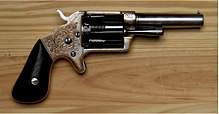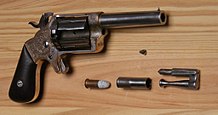Slocum revolver
The .32 caliber Slocum revolver was an attempt to circumvent Smith & Wesson's exclusive right to manufacture cartridge revolvers with a cylindrically drilled drum. The five-shot revolver was manufactured in 1863/1864 by the Brooklin Arms Company , Brooklyn , New York in just over 10,000 copies.
history
The aim of the development of the Slocum revolver was to develop a cartridge revolver with which cylindrical cartridges could be fired without infringing the Rollin White patent controlled by Smith & Wesson . In the system of the Slocum revolver, the drum bores, respectively. Cartridge chamber replaced by sleeves that were inserted into the barrel, which was open to the outside. The system was patented, a first patent was granted on January 27, 1863 (US Patent No. 37,551), an improvement of the ejector system on April 14, 1863 (US Patent No. 38,204) to the developer Frank P. Slocum.
Like the early Smith & Wesson revolvers , the Smith & Wesson No. 1 1/2 and No. 2 Army in caliber .32 with rimfire ignition , the Slocum revolvers were purchased by soldiers and officers for self-defense as backup weapons in the American Civil War .
technology
The five-shot Slocum single-action revolver fired .32 caliber rimfire cartridges long and short. The closed frame was made of brass, engraved and silver-plated. The barrel length was 3 inches. The handle scales screwed onto the frame were made of rosewood.
The barrel of the revolver was open on the outside. Cylindrical cases, which served as cartridge chambers, were pushed into the five openings from the front. To load these cases, one after the other, they first had to be unlocked and then pushed forward over the case ejector. A cartridge could then be inserted into the exposed opening in the drum. By pushing back the sleeve, the chamber was loaded. Fused cartridge cases were removed by the case ejector, which was firmly attached parallel to the barrel.




